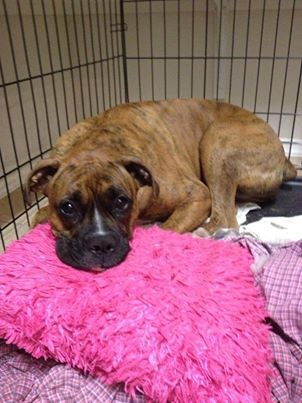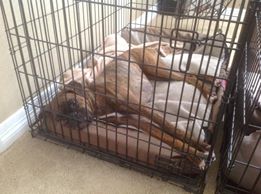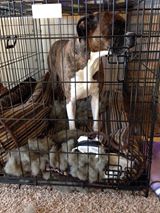
 Before we talk about the 4 easy ways to crate train your boxer. There are a few things you should consider first*. The following are a list of behaviors and issues that should be addressed prior to crate training:
Before we talk about the 4 easy ways to crate train your boxer. There are a few things you should consider first*. The following are a list of behaviors and issues that should be addressed prior to crate training:
- Dogs who suffer from fears or anxiety should not be confined in a crate.
- Dogs that have damaged the crate from attempts to escape or damaged surrounding reachable objects while inside the crate
- Excessive drooling while in the crate
- Urination or defection in the crate
- Dog moves the crate whileinside
- Excessive barking or howling while in the crate
- Too young to have sufficient bladder or bowel control
- Diarrhea, vomiting, or other illnesses
- Not sufficient exercise, companionship and socialization
*Note: Crates should never be used to discipline your dog. This teaches the dog to associate the crate negatively.
Step 1: Buy a crate!
 Crates come in different sizes and styles, consider the style and size of the crate before you buy it. Your boxer should be able to stand in the crate (without crouching). Crates can be expensive depending on the size and style of the crate you choose. The picture of the crate to the left is the one we have for our 65 lb. boxer, it cost us about $65. Here is the link: http://amzn.to/1igwSQ3
Crates come in different sizes and styles, consider the style and size of the crate before you buy it. Your boxer should be able to stand in the crate (without crouching). Crates can be expensive depending on the size and style of the crate you choose. The picture of the crate to the left is the one we have for our 65 lb. boxer, it cost us about $65. Here is the link: http://amzn.to/1igwSQ3
Make sure the crate has anything that you think will make your boxer more comfortable (pillow, blanket, toys). Of course, all kidding aside -boxers are known to get in trouble so consider carefully what you leave in the crate.
Make sure the crate has water. We used a water bottle instead of leaving a bowl. We did try a bowl, but quite frankly it ended up being a mess. We tried the a $15 version of this water bottle in plastic that hung by a wire. It lasted about 3 days. The water bottle pictured to the left is the one we have for our boxers and has been tested (by us) and deemed (for the most part) boxer proof. It actually mounts to the cage and is chew proof because it is glass. It cost us about $25 and is worth the extra couple dollars if you have a boxer 🙂
Step 2: Decide on a Location!
- Choose a high traffic area: Dogs (especially boxers) like to be around people. They are also denning animals. Once your boxer is trained, the crate will serve as the den. Find an area in your home that will accommodate both.
- Move the crate to bedroom at night: Again boxers want to be around their people. While you are training, keep the crate near you and move it into your bedroom at night. This is a little bit of an inconvenience right now, but your boxer will take to the crate much faster if you do this now.
Step 3: POSTIVELY Reinforce, Reinforce, Reinforce!
When your dog or puppy is in the crate positively reinforce with:
- Primary Reinforcers: food and treats
- Secondary Reinforcers: verbal praise and games
In other words, make it a rewarding and fun experience.
NEVER, NEVER, NEVER push, shove, pull or force your boxer into the crate. Also, do not punish your dog in the crate- this will make it a negative experience for the dog.
Step 4: Leaving The House
Start leaving the house when your dog feels comfortable being alone in the crate for about 30 minutes or so. Start leaving the house for short periods of time. As time goes on, you can increase the time and leave for longer. While there is no set of rules about how long to leave a dog in a crate, here is a general set of guidelines:
- 9 to 10 weeks – 30 to 60 minutes
- 11 to 14 weeks – 1 to 3 hours
- 15 to 16 weeks – 3 to 4 hours
- 17+ weeks – 4 to 6 hours
When you return, do not make a big deal and do not run to the crate to let the dog out right away. You do not want the dog to associate your coming home with getting out of the crate (although generally this will be the case). Get settled and then take the dog right outside to relieve itself. Don’t forget to positively reinforce while you are outside.
Frequently Asked Question!
Question: What should I do if I can’t get my dog or puppy to go in the crate?
Answer: Leave the crate open, feed them in the crate (start in close proximity to the door and move the bowl further into the crate at each feeding), leave treats in the crate the same way. It might take a little time to get them accustom to the crate.
Now it’s your turn, did you crate train? We’d love to hear your stories! Email: [email protected]
Did you like this article? If so, please go back to www.facebook.com/mydailyboxer and ‘like’ or ‘share’ the article -OR- pin the article on Pinterest!





